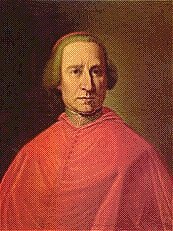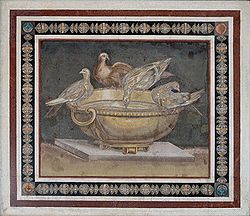
Giuseppe Alessandro Furietti
Encyclopedia

Cardinal (Catholicism)
A cardinal is a senior ecclesiastical official, usually an ordained bishop, and ecclesiastical prince of the Catholic Church. They are collectively known as the College of Cardinals, which as a body elects a new pope. The duties of the cardinals include attending the meetings of the College and...
, an antiquarian
Antiquarian
An antiquarian or antiquary is an aficionado or student of antiquities or things of the past. More specifically, the term is used for those who study history with particular attention to ancient objects of art or science, archaeological and historic sites, or historic archives and manuscripts...
and philologist
Philology
Philology is the study of language in written historical sources; it is a combination of literary studies, history and linguistics.Classical philology is the philology of Greek and Classical Latin...
, and a collector of antiquities
Antiquities
Antiquities, nearly always used in the plural in this sense, is a term for objects from Antiquity, especially the civilizations of the Mediterranean: the Classical antiquity of Greece and Rome, Ancient Egypt and the other Ancient Near Eastern cultures...
whose ambitious excavations at the site of Hadrian's Villa
Hadrian's Villa
The Hadrian's Villa is a large Roman archaeological complex at Tivoli, Italy.- History :The villa was constructed at Tibur as a retreat from Rome for Roman Emperor Hadrian during the second and third decades of the 2nd century AD...
at Tivoli
Tivoli, Italy
Tivoli , the classical Tibur, is an ancient Italian town in Lazio, about 30 km east-north-east of Rome, at the falls of the Aniene river where it issues from the Sabine hills...
rewarded him with the Furietti Centaurs
Furietti Centaurs
The Furietti Centaurs are a pair of Hellenistic or Roman grey-black marble sculptures of centaurs based on Hellenistic models. One is a mature, bearded centaur, with a pained expression, and the other is a young smiling centaur with his arm raised...
and other Roman sculpture
Roman sculpture
The study of ancient Roman sculpture is complicated by its relation to Greek sculpture. Many examples of even the most famous Greek sculptures, such as the Apollo Belvedere and Barberini Faun, are known only from Roman Imperial or Hellenistic "copies." At one time, this imitation was taken by art...
.
Furietti was born at Bergamo
Bergamo
Bergamo is a town and comune in Lombardy, Italy, about 40 km northeast of Milan. The comune is home to over 120,000 inhabitants. It is served by the Orio al Serio Airport, which also serves the Province of Bergamo, and to a lesser extent the metropolitan area of Milan...
, the son of Giovanni Marco Sonzogni Furietti, noble, of a local branch of the Sonzogni. He was educated at the Almo Collegio Borromeo, Pavia, then at the University of Pavia
University of Pavia
The University of Pavia is a university located in Pavia, Lombardy, Italy. It was founded in 1361 and is organized in 9 Faculties.-History:...
, where he received his doctorate in canon and civil law (utroque iure). In spite of his distinguished service to the Apostolic Camera
Apostolic Camera
The Apostolic Camera, or in Latin Camera Apostolica or Apostolica Camera, is the central board of finance in the Papal administrative system, which at one time was of great importance in the government of the States of the Church, and in the administration of justice, led by the Camerlengo of the...
, the cardinal's hat was withheld from him by Pope Benedict XIV
Pope Benedict XIV
Pope Benedict XIV , born Prospero Lorenzo Lambertini, was Pope from 17 August 1740 to 3 May 1758.-Life:...
, although Furietti dedicated to him his book on mosaics, partly in pique for Furietti's refusal to part with the famous marble centaurs for the Museo Capitolino
Capitoline Museums
The Capitoline Museums are a group of art and archeological museums in Piazza del Campidoglio, on top of the Capitoline Hill in Rome, Italy. The museums are contained in three palazzi surrounding a central trapezoidal piazza in a plan conceived by Michelangelo Buonarroti in 1536 and executed over...
, which had opened in 1734. Furietti was eventually created cardinal priest, by Clement XIII
Pope Clement XIII
Pope Clement XIII , born Carlo della Torre di Rezzonico, was Pope from 16 July 1758 to 2 February 1769....
in the consistory of 24 September 1759.
For a sum, Furietti obtained rights to excavate the section of Hadrian's Villa that belonged to Simplicio Bulgarini. As early as 1724, Conte Giuseppe Fede
Giuseppe Fede
Conte Giuseppe Fede was an Italian nobleman, collector and archaeologist of the 18th century. As early as 1724 he started to buy up parcels of land on the site of Hadrian's Villa at Tivoli and excavate on them...
had been buying up parcels of land in the extensive villa, which had become divided up among a multitude of owners, forming the nucleus of one of the outstanding recently-formed and non-papal collections of antiquities in Rome. After only a few days Furietti's crews found the famous statues of Centaurs signed by Aristeas and Papias, the "Furietti Centaurs
Furietti Centaurs
The Furietti Centaurs are a pair of Hellenistic or Roman grey-black marble sculptures of centaurs based on Hellenistic models. One is a mature, bearded centaur, with a pained expression, and the other is a young smiling centaur with his arm raised...
", which quickly became two of the most celebrated sculptures in Rome, in part through the engravings of them made in 1739 and 1740 under Furietti's supervision. Charles de Brosses
Charles de Brosses
Charles de Brosses, comte de Tournay, baron de Montfalcon, seigneur de Vezins et de Prevessin was a French writer of the 18th century.-Life:...
saw them displayed in Monsignor Furietti's apartments in the Palazzo Montecitorio
Palazzo Montecitorio
The Palazzo Montecitorio is a palace in Rome and the seat of the Italian Chamber of Deputies.- History :The building was originally designed by Gian Lorenzo Bernini for the young Cardinal Ludovico Ludovisi, nephew of Pope Gregory XV...
in 1739-40, and Francesco de' Ficoroni described them in Furietti's collection in 1744. Furietti habitually employed Bartolomeo Cavaceppi
Bartolomeo Cavaceppi
Bartolomeo Cavaceppi was an Italian sculptor who worked in Rome, where he trained in the studio of the acclimatized Frenchman, Pierre-Étienne Monnot, and then in the workshop of Carlo Antonio Napolioni, a restorer of sculptures for Cardinal Alessandro Albani, who was to become a major patron of...
as a restorer, hence some of the pieces that had passed through Cavaceppi's studio were illustrated from Furietti's former collection in Cavaceppi's self-promoting volume of plates, Raccolta d'antiche statue, busti, teste cognite ed altre sculpture antiche, 1768.

Mosaic
Mosaic is the art of creating images with an assemblage of small pieces of colored glass, stone, or other materials. It may be a technique of decorative art, an aspect of interior decoration, or of cultural and spiritual significance as in a cathedral...
s he found at Hadrian's Villa is the celebrated one of four doves drinking, found in 1737; Furietti was convinced that it was the very work executed by Sosius/Sosos at Pergamum, mentioned by Pliny the Elder
Pliny the Elder
Gaius Plinius Secundus , better known as Pliny the Elder, was a Roman author, naturalist, and natural philosopher, as well as naval and army commander of the early Roman Empire, and personal friend of the emperor Vespasian...
(Pliny's Natural History XXXVI,.25). It was the first plate in his book on mosaics, De Musivis (Rome, 1752), with six engraved plates, four of them folding, which became a classic on the subject. After Furietti's death, his heirs sold the two centaurs and the mosaic for 14,000 scudi, for the Museo Clementino.
Furietti was also a bibliophile. He edited and published the works of two of his compatriots, Gasparino and Guiniforti Barziza, and the poems of Publio Fontana, prefacing the volumes with brief vite. His personal library he bequeathed to his native Bergamo, with the obligation that it be open to the citizens. It became the nucleus of the Biblioteca Civico Angelo Mai; there some of Furietti's correspondence is preserved.
His tomb is in the Roman church of the Bergamaschi
Bergamo
Bergamo is a town and comune in Lombardy, Italy, about 40 km northeast of Milan. The comune is home to over 120,000 inhabitants. It is served by the Orio al Serio Airport, which also serves the Province of Bergamo, and to a lesser extent the metropolitan area of Milan...
, Santi Bartolomeo ed Alessandro dei Bergamaschi
Santi Bartolomeo ed Alessandro dei Bergamaschi
Santi Bartolomeo ed Alessandro dei Bergamaschi is a little church in Piazza Colonna in Rome, Italy, next to Palazzo Wedekind. Originally it was named Santa Maria della Pietà, from the high relief over the door...
, also called Santa Maria della Pietà.
The early biography is G. Gallizioli, Memorie per servire alla storia della vita, degli studi e degli scritti del cardinale Giuseppe Alessandro Furietti, (Lucca) 1790.
Sources
- Sonzogni, Ivano: Una Biblioteca per i bergamaschi di gran talento, il cardinale Furietti e la fondazione della Civica, in "Bergomum", Bollettino della Civica Biblioteca, n. 2, 1994, pp.5-46
- Sonzogni, Ivano: Il carteggio Alessandro Furietti - Pierantonio Serassi. Momenti dell'erudizione bergamasca a metà Settecento, in "Bergomum", n.2, 1996, pp. 91-188.

